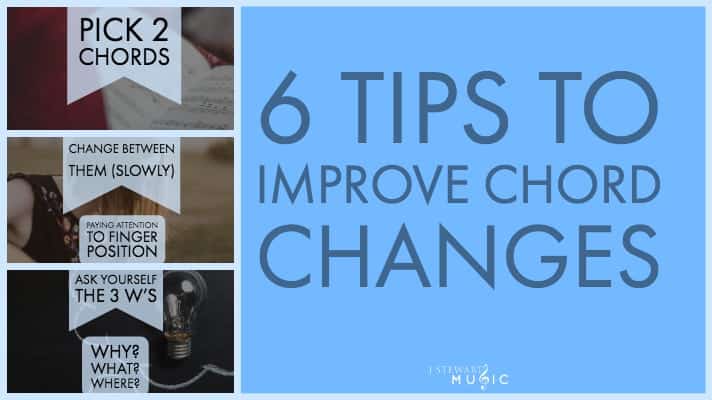When learning to play a new chord progression there are two difficulties nearly all students face: playing the chord and changing between them. This post (as you can tell by the title) covers the second one. Chord changes and changing between 1 chord and another can be one of the most frustrating parts of learning rhythm guitar and when I first taught it was one thing I found troublesome showing new students. When I got stuck with a chord – I said: “play it repeatedly, and eventually you’ll get it”.
Now, repeating chord changes can improve accuracy, and it will help, however if you’re a beginner teaching yourself with the help of a guitar teacher – which is where I started – there are a few things that will make the task take a little less time.
Slow. Slow. Slow. Slow. Slow. Slow!
Yes. I’m well aware I repeat myself nearly every blog post, and yes I know you’ll probably not listen, because guess what…neither did I. I stubbornly kept trying over and over, and repeatedly I never got my chords at the speed I wanted, I still didn’t get better, until I followed this one key point of advice. Slow down. The thing is, everyone says this advice, but it’s not just slow. It’s deliberate. It’s taking the time to recognize where your fingers go, to connect the dots (neurons) in your brain so your fingers and brain work together in perfect harmony. I will cover this topic of “slowness” in another blog soon.Make Mistakes… then fix them!
Yes. You need those mistakes those mistakes are part of the learning process, in fact they are the most important process. There are also many times where a mistake, is an option. Sometimes the best part of learning chords is actually the discoveries you make whilst making the mistakes. When mistakes exist, slow down more, you only make a mistake when you’re at the wrong tempo/speed. Give your brain time to create the correct network to the right finger position, pressure, etc. This will help you in so many ways.Repetition & Interleaving
Yup, I mentioned it at the beginning and it is still a useful tool in your learning toolbox but don’t just repeat the chord change again and again, 10 repeats and then move onto another chord, or do something different from chords, learn scales, play a song (more on that shortly). Once done, switch back to the previous chord, This technique, (interleaving), is powerful, and helps to keep your practices fun and keep you on your toes.Don’t rely on chord charts
Okay, so you’ve got chord charts, put em away and test yourself. Try remembering where your fingers go – the best way to help your brain learn things faster is to try doing it from memory. Try visualising the chord charts, or where your fingers go on the fretboard. Visualization is a wonderful technique – but can sometimes be a little mind-boggling. Still you’ll surprise yourself by how powerful some of these techniques are.Make It Important
Learning is stronger when it matters… – Make it Stick (By Peter C. Brown, Henry L. Roediger III & Mark A. McDaniel)Learning chords in isolation, is boring…and will get on your nerves. Something I’m learning in my short time teaching is how much students want to practice when they love the song they’re learning without that – even the most dedicated students get bored. They might love music but yearning begets learning. When a student really wants to learn something whether adult or child they will do anything to do it. I know when I wanted to learn True by Martin Taylor I spent hours over a 4 bar section to learn all the complexities or the chord changes and where I had to move my fingers, and that small 4 bar section I repeated frequently has changed the way I play forever and has helped me to become a far better and accomplished player. Because it’s important to me!
Two Chord Deliberate Practice
The most powerful method of teaching I use when learning to change between chords, is a method known as “deliberate practice”. This is a huge and well-researched topic, which has helped students progress at a fantastic rate. There are many aspects to deliberate practice, however in the specifics of this blog post; here is how I use it to help improve chord changes, alongside the other tips above!- Choose two chords you want to practice changing between (for example C to F)
- Incredibly slowly (unsurprisingly) change between the two, paying close attention to where your fingers go.
- After you’ve played between the two – ask yourself the following questions:
- Did it sound good?
- If not, why? If so… also why?
- Where did your fingers go? and did it work?
- Once you’ve answered these questions, change back to the other chord, and repeat steps two and three 🙂


Thank you. Every bit of help I can get to get better is much appreciated. I’ve gotten much better but I have not a wall. I play church songs and now my song list is repetitive. I just added the f chord to my arsenal. Which opened up more songs. It’s not easy when you reach yourself. Thank you for the information.
You’re very welcome Tommy! I also started learning songs via my local church (also played in the band as well). Teaching yourself guitar can be very difficult! The F Chord is a stickler for new players, and quite often gets in the way of progress! Which F chord will you end up using?